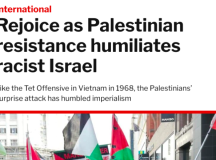Somewhere near the centre of the intellectual revolution of our times, and to the manner in which it has demonised the Jewish state, Israel, are new ways of thinking about ‘race’, racism and the couplet oppressor / oppressed that are associated with the concepts of ‘critical race theory’ and ‘whiteness’. Whatever the merits or demerits of ‘whiteness studies’ for the understanding of anti-black racism, it has tended to frame Jews and Israel as essentially ‘white’ and so essentially ‘oppressive’ with the result that contemporary antisemitism is denied by ideological fiat, granted no place in the related meta-theory of ‘intersectionality’. ‘Whiteness Studies’ often works in tandem with the related notion of ‘Zionist settler colonialism’ to underpin apologetics or even active support for antisemitic jihadists who are redefined as ‘the progressive resistance of the oppressed’. Fathom spoke to Balázs Berkovits, one of the most thoughtful critics of ‘Whiteness Studies’ and its role in weakening the fight against the antisemitism of our time. He warns that through this intellectual revolution ‘the meaning of “Jew” … is transformed, taking up all the connotations of “domination.” Thus, when “Jew” and “white” are combined in this discourse, it is the antisemitic content that ends up emphasised. In this mixture of a seemingly progressive critique of power and the oldest anti-Jewish stereotypes, it is the progressivism that is erased.’
Part 1: On the notion of ‘Whiteness’
Alan Johnson: Let’s start with the basic argument you have made about Critical Whiteness Studies as it impacts Jewish people and unpack it.
You wrote this in your 2018 article ‘Critical Whiteness Studies and the “Jewish Problem”’: ‘attributing “whiteness” to Jews is more than controversial, for it assimilates the most persecuted minority in European history to the dominant majority, while downgrading the significance of antisemitism.’
Perhaps – for readers who may not understand this use of ‘white’ not as a neutral descriptor but as a political or moral category meaning ‘the privileged’ or ‘the oppressor’ – we should start there? Let’s leave Jews out of it for now and just focus on this ‘critical’ usage of ‘Whiteness’. How did it get going at all? Did it emerge in academia? And what political meaning does the ‘critical’ usage of ‘Whiteness’ carry, as opposed to the descriptive term ‘White’?
Balázs Berkovits: The discourse on ‘whiteness’ began in the United States, where, in contrast to Europe, color and racial classification have always played a significant role. However, as the novel, racial (self-)understanding of social groups, and ‘race-based’ critique are gaining ground, as highlighted by ‘critical race theory’ and ‘critical whiteness studies’ in academia, it has also been exerting an increasingly greater influence in Europe.
Critical whiteness studies have been promoted as an activist scholarship; its goal is to question and de-essentialise whiteness, thus reducing some of its power—that is, to say, whiteness is a social construct rather than a biological fact. White is thus a color in and of itself rather than the absence of color.
The question ‘How does whiteness work as a racial norm?’ was the central issue of whiteness studies. According to Ruth Frankenberg, one of its founders, their intention was to ‘displace the “unmarked marker” status of whiteness, a continued inability to “color” the seemingly transparent white positionings.’ Even in previous critical analyses of racism, she claims, ‘whiteness remains unexamined—unqualified, essential, homogenous, seemingly self-fashioned, and apparently unmarked by history and practice’ (Ruth Frankenberg, in Displacing Whiteness, 1997, p. 1).
This new approach attempts to de-essentialise ‘whiteness’ while separating it from its ‘perceptual’ meaning as skin tone. It does this by treating ‘whiteness’ as a historical concept. As a result, it is said that individuals and groups can become white, which is acquired through a historically defined process of assimilation/acculturation. Therefore, the deconstruction of the supposedly neutral and essentialised category ‘white’ is often arrived at by writing the social history of ‘whiteness’: the way Italians, Irish, Russians and also Jews have become white in the US, against the backdrop of the persistent racial discrimination of the black population.
Regarding Jews, ‘whiteness’ was meant to represent the culmination of a historical process that saw discrimination and antisemitism gradually decline in the United States after World War II – although the increasing number of antisemitic incidents over the past two decades, and especially after 7 October strongly contradicts the latter hypothesis, even if it is only grudgingly admitted (or not at all), or often classified as a ‘non-systemic’ phenomenon.
AJ: And is the category ‘whiteness’ used by these theorists as part of a binary with ‘non-white’? Can every single person be placed within a binary framework of ‘whiteness’ and ‘non-white’? How is ‘non-white’ defined? How does it ‘work’?
BB: For the last couple years or even decades, we have been witnessing the re-essentialisation of ‘whiteness,’ with the ubiquity of race talk, talk about white fragility, etc. Within ‘woke’ discourse everything can be reduced to race, to racial and ethnic group membership. Individuals are construed as being fundamentally determined by collectives which are often racially defined. This is how ‘white privilege’ is acquiring importance in the discourse on social inequalities. The term ‘white privilege’ not only expresses inherited social status as unmerited advantage, but it narrowly associates it with skin color. Also, it often signals a kind of original sin, which is why white people in the US and maybe also in Britian are often sent by educational institutions or their employers to participate in training sessions to confess their guilt, owing to their belonging to the white group.
This biologisation of social difference is a very unfortunate tendency. For example, I believe that the question has never been asked: can a group deemed ‘white’ lose its status of whiteness? It should be possible though, if the socio-historical framework is taken seriously. By the same token, there are limits to the ‘whitening process,’ namely that Black and other dark-skinned people cannot become white: the theory forecloses the possibility of social integration for Blacks, since it is understood in terms of ‘whiteness.’ There is an obstacle embedded in the concept. So when social mobility is bound to skin color, or at least, when the most important indicator of inequalities is understood in terms of color, it is obvious that the image of social hierarchy that this conception conveys is uni-dimensional and extremely rigid.
Even from the beginning, there has been an inherent tension between two conceptions of ‘whiteness’ in ‘critical whiteness studies’: whiteness can be perceived as either the result of assimilation or an innate reality of skin color, but more often the two are blurred. For example, in Karen Brodkin’s so-called pioneering book on ‘Jewish whiteness,’ (How Jews Became White Folks, 1998) the name ‘Euro-ethnics’ seems to refer implicitly to skin color, subverting the original thesis according to which ‘whiteness’ is a historical construction. This is why she gets into circular arguments, since it is not clear whether Jews are already white, or at least prone to whiteness because ‘perceptually’ white, or, while considered non-white at the beginning, they only acquire this status over the period of couple of decades.
Now with the re-essentialisation of whiteness, the perceptual meaning of ’color’ is coming to the fore again as skin color, and as something established, fixed and unequivocal. When authors talk about the color line separating whites and blacks, color gains a much more literal significance. For if white privilege is mostly skin privilege in everyday situations (see the classic formulation in McIntosh, ‘White Privilege: Unpacking the Invisible Knapsack’, 1989), that is, being perceived as white, passing as white, then historical deconstruction of whiteness does not really help, for individual Europeans, let them be Irish, Italians or Jews, but also many Middle-Eastern Jews, will be perceived as white regardless of social history. So far, the relationship between whiteness as metaphor of dominant status (middle-class, mainstream, high volume of educational capital, etc.) and whiteness as skin color has not been meaningfully clarified; but we could have the feeling that the analysis falls back on skin color as default whenever the essential nature of the color line has to be demonstrated.
Part 2: Jews and ‘Whiteness’
AJ: OK, an obvious question next, but one many will have: Given Jews have many ethnicities and many are people of colour from the Middle East, North Africa, Ethiopia, how on earth do these theorists justify defining all Jews as ‘White’?
BB: By the same token you could ask: how on earth can some people think of Israel as a white ethno-state? Well, probably because some of those people have never visited that country. And some of those people have never seen a Jewish person of color, or even if they saw one, they don’t consider it as a paradigm case, but maybe just as an anomaly. When Jews were still considered a minority in the US, there were probably not many of them with a darker skin. Since historically most Jews in the US were immigrants or refugees from Europe, they were known to be Europeans. But of course, white supremacists don’t take Jews to be white, which mandates their racist attitude, while some left radicals think that they are ‘too white’ that is, part of the oppressive majority.
In fact, the case of American Jews could have contributed to a large degree to the deconstruction of ‘whiteness,’ precisely because this is a population different from other ethnic whites in so many respects. However, the theoretical drive of ‘critical whiteness studies’, or rather, its politically driven criticism overruled their primary intention. Coming to terms with the presence of antisemitism would have made this kind of theoretical overdetermination based on colour difficult to maintain. This is partly the reason why Jews constituted an (epistemological) obstacle to that criticism, and received the ‘white’ label. This obstacle is clearly expressed by Matthew Frye Jacobson, a ‘whiteness scholar,’ when he says that some people, and among them Jews, tend to ‘disavow any participation in twentieth-century white privilege on the spurious basis of their “parents” and “grandparents” racial oppression’ (Matthew Frye Jacobson, ‘Whiteness of a Different Color’, 1999, p. 7). For him, Jews are unequivocally white, in spite of their history of extreme persecution and the survival of antisemitism. Jews are white, even if they don’t accept it, or a fortiori.
But then here is a further problem: in this case it is the theoretician who is tagging people as white instead of observing the actors, the members of ethnic or ‘racial’ groups classifying each other, or coping with the racial hierarchy based on color in the US, which was completely new to Jewish immigrants (as it was convincingly analysed by Eric L. Goldstein in his ‘The Price of Whiteness’, which goes way beyond mainstream whiteness studies analyses, which he severely criticises). Now those are the ‘whiteness scholars,’ who reserve for themselves the right to distinguish white from non-white, ignoring or overruling the struggles of the actors involved. But it is simply not the researcher’s role to apply a racial label to certain groups. On the contrary, he or she must try to understand racial categorisation as the result of identification and counter-identification, of struggle and compromise, etc. The question is, then, how ‘Jewish whiteness’ becomes effective today, and how the application of this label to Jews by whiteness scholars, critics, or activists transforms the way they are perceived.
Whiteness has become a metaphor of privileged social position. And a very unfortunate metaphor, since it condenses skin color, social status, and domination: a perceptual aspect, a social aspect, and a critical aspect. It associates skin color which is a more or less natural attribute with social attributes of privilege in a context where every type of prominent position in the system of inequalities will be interpreted as ‘privilege,’ that is, an unmerited social advantage, associated with colour and ‘race.’ Small wonder that this mixture cannot properly function as a concept and eventually does more harm than good.
Part 3: Impacts and Exclusions
AJ: You write that the ‘Jews are White’ claim has meant Jews are ‘thereby excluded from the multicultural space of other, supposedly dominated, ethnic groups’. From the perspective of ‘whiteness’ studies, you note, once the Jews ‘gained acceptance in majority culture and society’ they ‘become part of the dominant and oppressive majority’. So what happens to the understanding of antisemitism in Critical Whiteness Studies?
BB: This perspective is analytically disabling because antisemitism does not follow the colour line. At the same time, as Karin Stögner has pointed out, ‘colour’ and ‘privilege’ are the main terms employed to talk about both racism and social inequalities in an intersectional framework. However, whiteness and intersectionality participate in the othering of Jews, and may yield antisemitic consequences.
As long as ‘whiteness’ is not so much about skin color (although, as we saw, the concept bears a lot of ambiguities), but is rather about the perception of the level of integration of minority groups of European origin, it functions as an interpretative concept. The ‘process of whitening’ of American Jews, which is supposed to have attained its fulfilment by the end of the Second World War, expresses a successful integration. However, ‘whiteness’ in ‘critical whiteness studies’ is also meant to express a position of domination and privilege, thereby becoming a critical rather than a merely interpretative concept. In this sense, white people as a collectivity would benefit from their dominant position in society and are equally complicit in oppression.
I believe there are three or maybe four levels of ‘Jewish whiteness’ that appear in these discussions, which, however, are not easily distinguishable. The concept progresses from neutralisation to criticism and at last to open accusation of Jews. In the first stage, the interpretative and critical parts of the ‘white’ word are still somewhat combined. Here, whiteness is supposed to neutralise Jewishness and prove the inexistence of antisemitism. Jews are no longer counted as a minority group, and it is said that there can be no serious or systematic antisemitism, as it cannot be conceptualised in terms of race and color, neither literally, nor metaphorically.
In the second stage, white is already only critical, as it is meant to express a position of domination and privilege. Jewish achievement and acculturation are being portrayed as undeserved and unfair privilege. Jews are now seen as members of the white and racist majority, benefitting from their newly gained position as whites. In a context of enhanced identity politics, where racial belonging, the color line, and talk about white privilege (essentially referring to skin color) are becoming increasingly important, Jews become part of the white and racist majority, profiting from their newly acquired white positionality. White means skin privilege but also economic privilege and social status.
In the third stage, Jews are even portrayed as becoming ideologues of white, racist, capitalist society who, furthermore, connect with Zionism. For ‘whiteness scholars,’ Jews’ social mobility occasionally signifies the ‘betrayal’ of a genuine minority status, together with the alliance with the capitalist system, the wholehearted identification with white America, and the West, and even anti-black and anti-Muslim racism.
The concept of ‘whiteness’ thus colonises the ‘Jew,’ and automatically invites criticism. Under the guise of a critique of power and domination, this rhetoric presents itself as being free of antisemitism. However, the ‘Jew’ not only reinforces the ‘white,’ but, as it was shown by David Schraub, becomes the ‘super-white’: the meaning of ‘whiteness’ is changed by the appendation of the ‘Jew.’ But it is especially the meaning of ‘Jew’ that is transformed, taking up all the connotations of ‘domination.’ Thus, when ‘Jew” and ‘white’ are combined in this discourse, it is the antisemitic content that ends up emphasised. In this mixture of a seemingly progressive critique of power and the oldest anti-Jewish stereotypes, it is the progressivism that is erased.
Part 4: Whiteness and Israel
AJ: You cite Sander L. Gilman on the parallelism of this new way of thinking of Jewish people and new ways of thinking of Israel. Gilman writes: ‘The trajectory of the image of Israel from the embattled, overwhelmed, rescued fragment of European Jewry to “Super-Jew” and then to “racist” archvillain parallels this cultural tale.’ i.e. this tale of enriched and secure Jews in the West. Can you talk about how ‘critical whiteness studies’ has been reshaping understandings of Israel?
BB: In fact, when racism and whiteness scholars deal with the question of Israel, they often turn to the theoretically overdetermined concept of ‘whiteness,’ as it was described previously. Zionist Jews are framed as European white people settling in the Middle-East, which already prejudges of their status as colonisers. This means that the features attributed to Zionist settlers originate in their presupposed social and ideological characteristics (condensed in the ‘white’ formula) and much less in their actual or past practices (which are always interpreted in the light of their labeling as ‘white settlers’). From then on, the stereotypes associated with whiteness, racism, or the ‘ethnic state’ will prevail in the interpretations, without further empirical research into the actually existing Israel or its history. In these analyses the totally spurious whiteness frame is preponderant.
For example, according to Abigail Bakan, a Canadian racism scholar, a Marxist and postcolonial writer, American Jews had been progressively whitened during their history on American soil until the end of World War II, whereas the whitening of European Jews came about with Zionism. ‘The two processes intersected,’ asserts Bakan, thereby creating the entity known as Israel. Furthermore, Bakan thinks that the Jews remaining in the European diaspora have been further whitened as a result of the creation of Israel as a white racist state.
Others, like Gabriel Piterberg, Gershon Shafir, and many more have similar views stemming from very schematic conceptions. By asserting that Zionist settlement is a resettlement of a European population ‘in a land controlled by a colonial European power’, followed by the creation of a sovereign state, or by the seemingly rational interpretative choice of placing it in the wider context of European colonisation without further ado, they think that Israel is the result of ‘white-settler colonialism’.
Now the problem, that is, the ‘Jewish problem’ emerges in these discussions when the supposedly colonial features of Zionism and Israel are at the same time taken to be Jewish features of whitened Jews. These Jews are white dominators, pursuing Western colonialism and mystifying the world concerning their deeds, relying on Holocaust memory for impunity. The characteristics of the discourse analysed above point to the linkages and even the potential common ground between anti-Zionism and antisemitism. Jews as Western, white, privileged, powerful oppressors – harks back to antisemitic imagery, where it is the ‘white’ adjective that makes the only difference. Inserting the ‘white’ label between Jews and their critique supposedly renders this discourse anti-hegemonic, because now Jews are not criticised/accused as Jews; the presence of the ‘Jew’ appears to be neutralized as a result of ‘whiteness.’ It is seemingly only their ‘being white’ that is under critical scrutiny. However, as we saw, it is precisely the ‘white’ adjective that liberates and even enhances antisemitic talk. Therefore, it can be established that it is the problematisation of Jews and their ascribed characteristics, which, with the help of the “white” label, qualify Israel as colonial, and single it out for attack – which shows the importance of analysing the “white” and the “colonial” thematic together.
Part 5: ‘Whiteness’ and the ‘Zionist Settler Colonialism’ Theory
AJ: Let’s examine further the link between the notions of ‘whiteness’ and ‘Zionist settler colonialism’. You have written that one impact of the ‘Jews are White’ claim is that ‘Jews can be presented as white dominators in the Middle East, colonising the autochthonous non-white Arab population. By analogy, the color line is introduced into conflicts which have nothing to do neither with the American race relations, nor with a European type of colonialism.’
BB: First, it should be mentioned that the definition of ‘colony’ serves as the strongest argument against the establishment of a state or other administrative entity. A colony, in the politically charged sense of having resulted from colonialism (and thus to be differentiated from the more neutral term ‘settlement’), ought not to exist by definition, since it was created through land grabs, conquest, and the exploitation, oppression, and frequently the eviction and even the genocide of the native population. It is therefore illegal, and decolonisation is necessary.
Consequently, a state is destined to be destroyed if historical investigation reveals it to be a colony on an interpretive level, since it renders it illegitimate on a normative level.
As a result, colonialism has come to represent an explicit and morally presumptive rejection of Zionism and the State of Israel. On the other hand, it is by no means clear what Zionism’s ‘colonial nature’ should mean. Israel was undoubtedly viewed by the left as a post-colonial state upon its founding. There was no ‘mother country’ helping its establishment, while Zionists didn’t conquer any land or displace any population by force until the first Arab-Israeli war in 1948, which was a defensive and even an existential war against the invading forces of Arab countries and Palestinian militias.
Nowadays, anti-Zionist detractors have been ecstatic about this allegedly revolutionary colonial (or rather, ‘settler-colonial’) viewpoint since they believe it to be the final evidence of the Jewish State’s illegitimacy. The writers either treat Israel’s contemporary history—which spans from the early days of Zionism to the present—as a whole as a colonial endeavor without giving it any further thought or drawing any significant divisions between different historical periods; or they explicitly affirm that no distinction should be made between the periods of before and after the Six-Day war, as the whole history of modern-day Israel would follow the same logic from the beginning.
Indeed, much of post- or anti-Zionist historiography has used the Six-Day War and the Israeli occupation of the West Bank as the foundation for retroactively portraying Zionism’s whole history as a colonial endeavor by employing a teleological perspective. Furthermore, this conceptualisation has relied on a very broad definition of colonialism, which purposefully blurs the lines between colonisation and colonialism and has extremely loose and flexible requirements for what qualifies as such.
Therefore, the inclusion of Israel among the ‘settler colonial’ states is conceptually (and much less empirically) directed, first, by the manipulation of the usual binary oppositions: native—settler, indigenous—European colonists, oppressor—oppressed; second, by the conceptual association of settler colonialism (or the act of settlement) with a so-called fundamental intention of the ‘elimination of the native’ comprising ethnic cleansing, murder, and even genocide; and, third, by seemingly empirical comparisons to other settler colonies—which are at best superficial and far-fetched, and at worst totally factitious.
The thought that Israel is inherently genocidal is anchored in the interpretative framework that construes it as colonial or settler-colonial in the Western style, constantly practicing oppression and apartheid. That Israel is committing genocide against the Palestinians is always assumed, therefore there remains nothing to verify when there is an actual conflict. This has become clear after 7 October. The accusation was automatically triggered, even when facts on the ground were not known. And there has been no genuine intention of finding out the facts by the accusers (let them be politicians, journalists, or representatives of certain NGOs). And conversely: the genocide committed against Israelis cannot be perceived, let alone recognised, since they are known to be the fundamental oppressors.
AJ: So the ‘Jews are White’ claim has become part and parcel of the ‘Israel is a settler colonial society’ claim, yes?
BB: Interpreting Jews in the whiteness frame accomplishes the impossible by a number of conceptual reversals: Jews are white, therefore don’t have the status of a minority; Jews have been powerful colonisers in the Middle East and not the most persecuted human group in history; Jews have been profiting from the Holocaust than anything else, by making it seem as if it was unique, etc. Jews are seen as accumulating all the dominant positions in Western societies, unjustly vindicating the status of utmost victims, and illegitimately complaining about antisemitism, which they even instrumentalise to defend Israel and to denigrate real minorities, like Muslims (what detractors call the ‘antisemitism card’).
With respect to Jews, everything is interpreted in the framework of ‘privilege”: Jews’ social and economic status, their educational capital, alleged ‘skin privilege,’ their ‘Holocaust credit.’ Every objective position they occupy in the social hierarchy is to be criticised as unearned, unmerited, and even harmful, whereas every grievance (Holocaust memory, antisemitism) is tagged as factitious and fake, in need of deconstruction.
Jewishness, then, represents a form of ‘counter-intersectionality,’ a sort of theoretically designated enemy, characterised by the combination of dominant positions, all appropriated by ‘white Jews.’ If Jews are thus erased as a minority, they are, at the same time, enhanced as a group of subjugators. They accumulate the traits of domination, whereas intersectional theory is built on the accumulation of structural disadvantages. This perspective transfigures the attacks against Jews as legitimate social critique, leading to the theoretical neutralisation of antisemitism. By purportedly using some social-scientific concepts and procedures, whiteness and race scholars as well as other ‘social critics’ frequently implicitly, but occasionally even directly, support a number of anti-Jewish stances that are presented as anti-hegemonic positions. This means that the critique of Jews in Western societies is presented as a legitimate social critique, stemming not from hostility to Jews, but from a political position, susceptible to being bolstered by rational arguments (the same way as antizionism is taken to be just a political position, which has nothing to do with antisemitism).
Part 6: The ‘good’ Jews of Whiteness Studies
AJ: You write that according to the critical whiteness theorists ‘there are also “good Jews”, those whom we perceive as non-white, suffering not only from white privilege as such, but most particularly from their own fellow white Jews, and never with them, therefore never from antisemitism.’ Who are these ‘good Jews’? Mizrachi Jews?
BB: I was once at a conference, and a scholar of Israeli origin, a self-identified Mizrachi Jew who now lives in Britain and has been for the last twenty years or so, said that he personally never experienced antisemitism, only racism, as he has darker skin. Or, he said, what he experienced as a Jew was discrimination because of his darker skin. This means that he was discriminated against as a Middle-Eastern, as maybe being perceived as an Arab but never identified as a Jew. Therefore, he concluded from this personal experience of his, that there is no antisemitism, or that antisemitism equals racism. With all due respect to his personal experience, how could one generalise from this? In his solidarity with Middle Eastern people, he maintains that there is no specific racism towards Jews, because it’s only about skin color. A further consequence is that Ashkenazi ‘white’ Jews cannot experience antisemitism/racism, which is plainly absurd.
Buth then, he surely was never perceived as a Jew, maybe because of the stereotype that Jews are white. So what this person and others are saying is simply that they are passing as non-Jews, since they are not white. (Curiously, this would be the only instance of passing when you pass as a person of color in order to not to experience a certain type of discrimination, namely antisemitism). If this is true, then Jews of color would be spared of antisemitism. But obviously, this cannot be true in general, especially not if they are religious, or if they bear any other conspicuous sign of their Judaism. It’s more of an illusion or an ideological construct of those people who would want to stand in solidarity with those whom they perceive as the truly oppressed.
Tracing the color line even inside the Jewish community may have dangerous consequences. The ‘intersectionality of colors’, in which Jews of color would participate, overrules Jewishness, denies the relevance of antisemitism, and may even pinpoint the ‘white Jew’ as the culprit, as the global enemy of colored people. In this discourse Ashkenazim are white, therefore privileged, whereas Sephardic and Mizrahi ‘Jews of color’ are oppressed both in the US and Israel, suffering essentially the same lot as the Palestinians. The message is not only that the division between white and non-white should be relevant in the interpretation of privilege and domination universally; but more importantly, that these phenomena should be conceived exclusively in terms of color. The antisemitic phenomenon, under its various forms appearing in human history, is completely excluded by this imaginary division of Jewry.
Of course, nobody should deny the potential discrimination on the basis of skin color even in the case of Jews. But if this is the only type of discrimination that is mentioned, it surely eclipses the specific features of antisemitism. Namely that Jews are for the antisemites always oppressors, dominators, conspiring against the majority, whereas this is never said of Blacks and other minorities of color. In the racists’ eyes Blacks, Arabs, people of color are always inferior. On the extreme-right, even the European migrant crisis was attributed to a Jewish plot, taken as its ultimate driving force. According to the theory of the ‘Great replacement,’ Jews have a plan of flooding Europe with migrants, thereby subverting European culture, since those people cannot have a plan on their own!
AJ: Can ‘anti-Zionist’ Jews also qualify as ‘good Jews’? What are the entry requirements and who hands out the Certificate of Good Standing?
BB: There are some Jews who are trying to prove their anti-Zionist credentials, because of fear or conformism, but also as a consequence of their genuinely held democratic beliefs (although the image they have of Israel and Zionism is most of the time erroneous or one-sided). Some people attribute this attitude to ‘self-hatred,’ but this is too easily and widely applied, referring to the individual psyche, therefore unverifiable. I think that the motives are less psychological than political, or at least they are stemming less from a sort of identity crisis, and more from social pressure. As Shalom Lappin has put it in a recent article in Fathom, Jews are the only ethnic group that is subjected to a ‘political acceptability test,’ which, furthermore, is ever changing. As it was also confirmed by Susie Linfield, self-avowed Zionists have long been ostracized from intellectual circles in the US that consider themselves ‘progressive.’ Perhaps, this could be alleviated eventually by the enthusiastic espousal of the two-state solution, and the emphatic denunciation of the occupation of the West Bank. But one doesn’t need to be a Zionist, it is enough to be a Jew for being questioned concerning his position on the Israeli-Palestinian conflict. And there are no multiple good answers. According to Lappin, there came the period when one had to advocate for one state between the river and the sea (which in practice, of course, would mean the disappearance of the state of the Jews). However, after 7 October, the ‘progressive’ anti-Zionist position has further radicalized, and now the identification with the Hamas agenda (presented as a pro-Palestinian position) is required: the explicit demand of removal of Jews from the territory became the order of the day. Who would want to be canceled because of a political stance in favor of Israel, especially when one identifies with many items of a ‘progressive’ political agenda? Still, most Jews weren’t willing to follow.
Part 7: The Critique of the Critique
AJ: And so, this is a kind of theoretical and methodological package deal, yes? There is ‘Jews are White’, there is ‘Israel is settler colonialist’ and there is framework of analysis known as ‘intersectionality’? So Jews, including the Israeli Jews, have been, to use a colloquial expression we have in the UK, ‘done up like a kipper’? Who should people read for critiques of this demonising package deal?
BB: Perhaps, contemporary anti-Zionism can be best described with the help of the term ‘cultural code.’ What Shulamit Volkov calls (in the wake of Karl Mannheim and Clifford Geertz) a cultural code, and specifically the 19th century antisemitic one she unearthed, is a simplistic ideological world view oriented to criticise the contemporary world, while it is instrumental for federating sometimes very different political stances and agendas. As David Nirenberg has recently put it, highlighting particularly the ‘critical side’ of the antisemitic issue: ‘We live in an age with its own “Jewish questions,” an age in which many millions of people are exposed daily to some variant of the argument that the challenges of the world they live in are best explained in terms of “Israel”’.
The task is to map the anti-Zionist cultural code enmeshed with contemporary social and political critique. The study of the ideological structure of present-day anti-Zionism as cultural code invites a multi-faceted approach to examine in detail the interplay between the critical-epistemological aspects present in today’s activist ‘new academy’ and the socio-political and also moral aspects of political, academic, and civil rights activism, resulting in today’s uninhibited antisemitic anti-Zionism.
The emergence of contemporary radical forms of anti-Zionism as cultural code can be linked, on the one hand, to a number of theoretical choices in critical social science, which lowered its epistemological level (some of these were analysed by Robert Fine, Philip Spencer, Moishe Postone, Danny Trom, Karin Stögner, Ingo Elbe, Marcel Stoetzler, David Hirsh, and others) and which determined the outlook of the ‘new academy.’ This outlook is paired with a certain common practice and ‘ethos’ of critique, which has largely diverged from rationally founded critical theories (based on social science striving for objectivity and/or Enlightenment philosophy). For example, ‘critical whiteness studies’ and ‘critical race theory,’ heirs to a once respectable sociology of race, are now infused with identity politics, and label Jews as ‘whites.’ Other disciplines, which are heirs to ‘postcolonial theory,’ such as ‘settler colonial studies,’ clearly follow a political agenda that they call ‘liberatory,’ largely focusing on Israel, to the detriment of research, and empirical findings.
On the other hand, anti-Zionism as a cultural code is political, insofar as it is both an extremely narrow and dogmatic perspective on the world and a broad ideological toolkit or a surface of projection of ideas that are not organically related to it. It functions as a theoretical shortcut to the understanding and critique of ‘imperialism,’ ‘global hegemony,’ etc.; and it serves as a common denominator for groups intending to promote various ‘progressive’ agendas, or for groups and individuals who are just trying to act in conformity with the ‘righteous’ opinion.






































